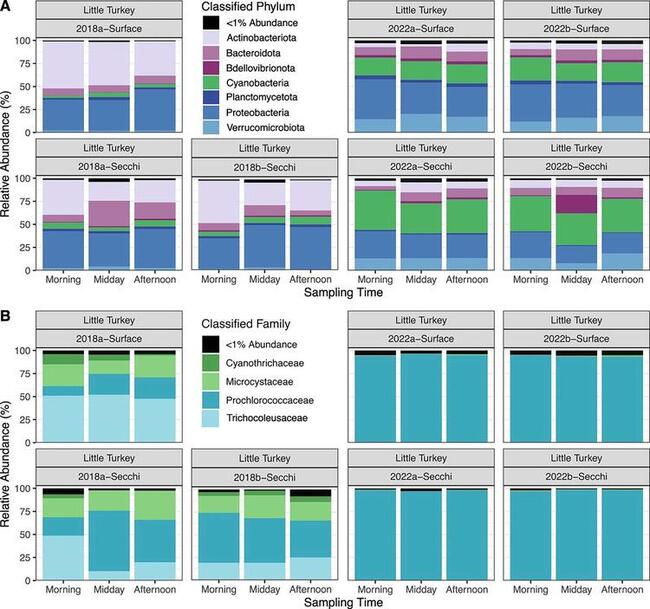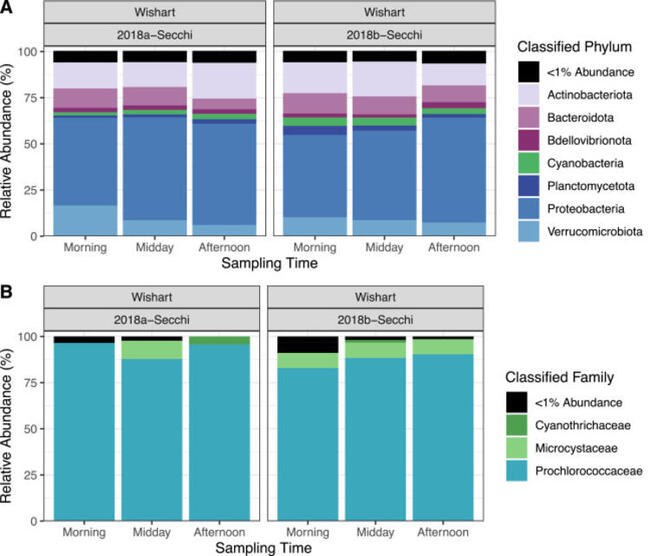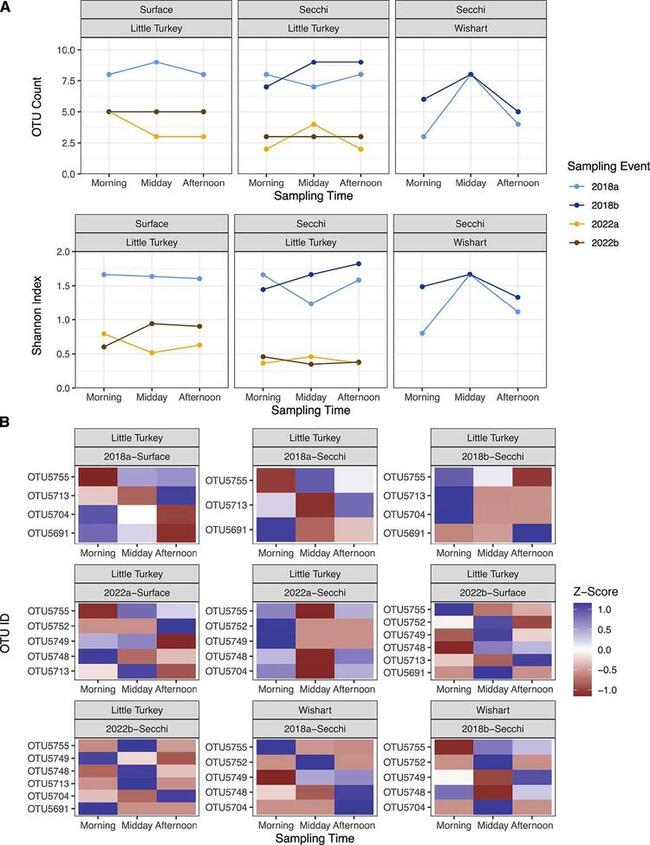Contact

Kirsten Müller
Department of Biology

Ellen Cameron
Department of Biology

Monica Emelko
Department of Civil and Environmental Engineering

Anjali Krishna
Department of Biology
Introduction
Cyanobacteria pose a threat to surface waters impacting recreational water use and drinking water quality. Human activities have increased the frequency and intensity of cyanobacterial algal blooms, while climate variability and associated landscape disturbances such as wildfires have further promoted their proliferation. Continued increases in harmful algal bloom occurrences requires new or additional guidance for source water protection and drinking water safety plan development.
A key factor to be considered in risk management planning is an assessment of potential diurnal fluctuations of cyanobacterial populations, a phenomena reported in marine and eutrophic freshwater systems but scant in oligotrophic freshwater lakes. This study evaluates the impact of diurnal migrations and water column stratification on cyanobacterial abundance and composition in a shallow well-mixed lake and an interconnected, thermally stratified lake.
Methodology
To evaluate the impact of diurnal fluctuations on cyanobacterial abundance and composition, communities were characterized in a shallow well-mixed lake (Wishart Lake) interconnected to a thermally stratified lake (Little Turkey Lake) in the Turkey Lakes watershed near Sault Ste Marie, Ontario on the Canadian Shield. These lakes are classified as oligotrophic to mesotrophic, and cyanobacteria have been reported as the dominant members of phytoplankton communities.
Water samples were collected in both lakes at three different times across a two-day period in 2018 and August 2022 from Secchi depth, the maximum depth at which there is sufficient light for photosynthesis. Samples were also collected at different depths in Little Turkey Lake to investigate the impact of thermal stratification on cyanobacterial communities.
Amplicon sequence variants (ASVs) of the 16S rRNA gene across the sample sets were clustered to generate a representative set of sequences of the entire microbial community. Sequences classified as cyanobacteria at the phylum level were then aligned to reference sequences and were manually curated to reflect taxonomic levels above the genus level. This analysis allowed an evaluation of the relative abundance of genera in the cyanobacterial community as well as an estimation of the changing community diversity at different depths over different time points.
Outcomes
Cyanobacteria were observed to comprise a variable proportion of the bacterial community across sampling events, with relative abundances more similar at Little Turkey Lake than Wishart Lake in 2018 (Figures 1 and 2). At Little Turkey Lake, interannual variability had a significant impact on cyanobacterial communities. In 2022, the composition of the cyanobacterial communities was highly similar regardless of spatio-temporal differences but did appear to be in higher relative abundance at Secchi depth at all time points during the day. In 2018, communities at the water surface and Secchi depth were similar though members of potentially toxin producing taxa were present at both depths at all time points. The significance of sampling time and sampling site were also observed for bacterial community composition.

Figure 1. Composition of bacterial communities by the relative abundance of major bacterial phyla (A) and major cyanobacterial families (B) measured across a multi-time point sampling series over two consecutive sampling days (2018a/2018b, 2022a/2022b) in a thermally stratified lake (Little Turkey Lake).

Figure 2. Composition of bacterial communities by the relative abundance of major bacterial phyla (A) and major cyanobacterial families (B) measured across a multi-time point sampling series over two consecutive sampling days (2018a/2018b) in a shallow, non-stratified lake (Wishart Lake).
In 2018, a higher number of cyanobacterial ASVs were detected in comparison to the 2022. Although results from Wishart Lake are limited to 2018, it had corresponding spikes in diversity at the midday sampling point on both sampling days contrary to the sporadic diurnal fluctuations of diversity observed in Little Turkey Lake. In both lakes, cyanobacterial communities were predominantly composed of OTUs classified to the family Prochlorococcaceae but potentially toxin producing taxa were observed consistently at Secchi depth. During both sampling events the analysis revealed common OTUs over time and across depth that differed in relative abundance (Figure 3).

Figure 3. Temporal fluctuations in cyanobacterial communities driven by changes in OTU detection (A) and composition (B).
Conclusions
This novel study showed that cyanobacteria are present in oligotrophic lakes and their community structure varies (i) diurnally, (ii) across the depth of the water column, (iii) interannually within the same lake and (iv) between different lakes that are closely interconnected within the same watershed. In contrast to trends frequently observed in marine and eutrophic freshwater systems, the study demonstrated that in oligotrophic systems diurnal fluctuations of cyanobacterial populations are sporadic, but overall bacterial community composition is conserved temporally. Consequently, these contrasting results - especially the unpredictable nature of cyanobacterial population distributions - have significant implications for the development of water quality monitoring programs and associated risk management strategies. This study also emphasized the importance of understanding the system that is being evaluated for risk of toxic algal blooms.
Study results demonstrate the need for integrating multi-timepoint, multi-depth discrete sampling into lake and reservoir monitoring programs in order to describe cyanobacteria community dynamics and signal change to inform risk management responses associated with the potential for cyanotoxin production. Ignoring variability in cyanobacterial community dynamics and reducing sample numbers can lead to a false sense of security and missed opportunities to identify and mitigate changes in trophic status and associated risks such as toxin or taste and odor production, especially in sensitive, oligotrophic systems.
The increased availability and decreasing costs of next-generation sequencing tools have eliminated many of the barriers to their wider use in resource management and the drinking water industry. Although amplicon sequencing has revolutionized the ability to study microbial communities, these data do not quantify abundance of community members. However, to best inform cyanobacterial community dynamics for resource and risk management, the Emelko and Müller labs are also using quantitative PCR methodologies to quantify the number of genes (toxin and 16S rRNA genes) to identify potential toxin producers and their abundance and evaluation of the presence of toxins to better understand how cyanobacterial communities can lead to toxic events in water.
Read more in Water Research
Cameron, E. S., Krishna, A., Emelko, M. B., Müller, K. M. Sporadic diurnal fluctuations of cyanobacterial populations in oligotrophic temperate systems can prevent accurate characterization of change and risk in aquatic systems. Water Research, March 2024. https://doi.org/10.1016/j.watres.2024.121199
For more information about WaterResearch, contact Julie Grant.
Listing photo: Light rays from under water texture by Heath Alseike.







